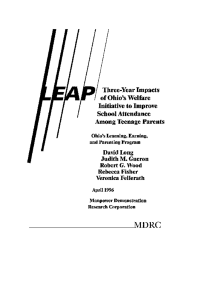LEAP: Three-Year Impacts on Ohio’s Welfare Initiative
This report presents three-year impact findings on Ohio’s Learning, Earning, and Parenting Program (LEAP), which, throughout the early 1990s, used financial incentives and penalties, case management, and support services to promote school attendance among teen mothers on welfare. Tying the size of welfare grants to teen mothers’ presence in school, the program sought to foster school completion, increase employment and self-sufficiency, and reduce reliance on public assistance. The report offers the following conclusions:
- For teens who were already enrolled in school, LEAP increased school completion (primarily through completion of a GED, a high school equivalency certificate) by almost 20 percent and increased employment by over 40 percent.
- For dropouts, there was no increase in school completion or employment, despite large grant reductions.
- Overall fewer teens remained on welfare, although the receipt rates were still very high.
- In Cleveland, but not in Ohio’s other large cities, LEAP substantially increased high school graduation rates, suggesting the importance of both providing special services to keep teens in school and setting restrictions on leaving high school to enter a GED program.
A final report on the LEAP program was published in 1997.







